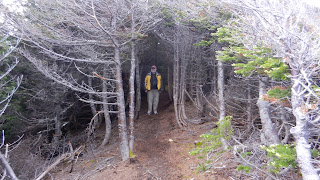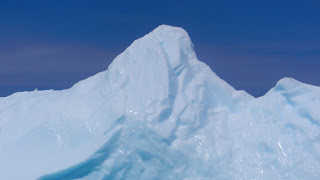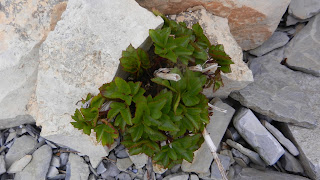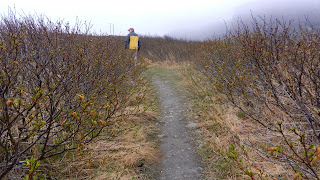We weren't the only ones to search for a better view of the iceberg. Several tour buses were tentatively negotiating the narrow, winding roads to capture that perfect shot. No wonder folks were excited: last year not one iceberg showed up until September. We had arrived at the perfect time to see icebergs. There had been two weeks of prolonged northeast winds pushing them in our direction.
On the way into town, we noticed several signs selling lobster; there were few if any on the western coast. We made our way through town and toward Peyton's Woods RV Campground. We had the pick of sites so we chose one closer to the road with a clear view of Back Harbour. Rocky and hilly, we had our choice of footpaths and trails to follow. We picked ourselves up and walked on over to Back Harbour.
Footpaths, used by many generations, abound and for good reason. If you are a fisherman and want to know what the seas are like, it is much more efficient to hike up the path to the top of the hill and look than to take your small boat out and find out the hard way.
Back at our campsite it was time to eat the lobster we bought in Labrador. Our Roadtrek has a very good freezer unit in the refrigerator, so our lobster was still in good condition.
The next morning we followed a trail into the nearby woods to find a geocache. Just off the path in an area that was rocky and moss-covered, the geocache was well-hidden; but we found it with a little bit of walking in circles. The trees affect the GPS's ability to get a good fix, but the Garmin 62st does the best job of it than any of my other GPS's.
We still had time to kill before our afternoon cruise to the iceberg, so we explored the area around Long Point Lighthouse. There are two geocaches in the area, but we did not have time to do the hikes and still make our boat. Instead, we walked the trail up to The Pinnacle. We parked the Roadtrek at the bottom of the hill in an area that looks to be an old fishing harbor, but is being used now for a playground and picnic area.
Long Point Lighthouse sits on top of one of the steepest and most imposing shorelines I have ever seen. Trails crisscross the landscape with signs warning of the treacherous paths ahead and down.
Taking the tour boat out to the iceberg was well-worth the time and expense. Just seeing a piece of ice 10,000 years old so close that I could see the intimate curves, the plastic-like surface glistening in the sun. I wanted to pat it, to speak to it, absorb it. See for yourselves.
The captain drove all the way around twice before he had to head back for his next cruise. Even though the winds were fairly light, motoring out the cove and around to Twillingate was a bit rolly, another way of saying we had 6-8 foot swells crashing into the rocks
...cruising through retirement aboard S/V Beowulf, M/S Sandpiper and our "land yacht" Shorebird, a 210 Versatile Roadtrek.
Friday, September 7, 2012
Monday, September 3, 2012
Newfoundland6
Knowing we had to backtrack in order to pick up the TransCan, we detoured off of Hwy 430 and took Hwy 432 to Plum Point instead. It gave us a good view of the interior of the Northern Peninsula, thickly forested with Douglas Fir and White Pine. Along the way, we spotted several garden plots. Newfoundland is so rocky that residents search out a narrow space along the road with fertile soil and plant a garden. We were there in June, a bit like April in Indiana, so gardens were being turned (by hand) and row hills were established for root crops.
Along with the garden plots, there were many log "yards". Some contained piles of split logs while others were neatly stacked in rows. We assumed that snowmobiles pulling wooden sleds were used to haul the timber back near the road for cutting.
The long stretch of highway apparently didn't hold Missy Moo's interest, so a little vocabulary lesson might be in order:
Tuckamore - most of the hikes we have taken in search of geocaches have taken us across an area called tuckamore, an area of low-lying bushes and trees,often twisted and stunted by the constant winds. Tuckamore contains many plants that produce edible berries important to thousands of migratory birds and a staple in every larder such as bakeapple, partridgeberry, wild blueberry, squashberry and crowberry.
Tickle - A tickle is a narrow salt-water strait as an entrance to a harbor, considered treacherous because of its narrrowness and/or the tides.
It was almost a two-day trip back down the Northern Peninsula and then taking the TransCan until we came to Hwy 340 which would take us to Twillingate. Even though we were determined to explore every peninsula, we did bypass Baie Verte Peninsula. We could, however, add two moose and one coyote to our animal count.
Just before arriving in Twillingate, we spotted a large iceberg in a cove to our right. We turned around and took a road in that direction in hopes of seeing it close by, but the road ended in a cluster of homes and the rocky hills blocked our view. After crossing a bridge, we turned right again and did find ourselves across from the iceberg, but still not as close as we wanted. Driving through Twillingate, we took note of several tour companies offering whale watching and iceberg viewing. The next day we hoped to see that iceberg up close. The fun was just beginning.
Along with the garden plots, there were many log "yards". Some contained piles of split logs while others were neatly stacked in rows. We assumed that snowmobiles pulling wooden sleds were used to haul the timber back near the road for cutting.
The long stretch of highway apparently didn't hold Missy Moo's interest, so a little vocabulary lesson might be in order:
Tuckamore - most of the hikes we have taken in search of geocaches have taken us across an area called tuckamore, an area of low-lying bushes and trees,often twisted and stunted by the constant winds. Tuckamore contains many plants that produce edible berries important to thousands of migratory birds and a staple in every larder such as bakeapple, partridgeberry, wild blueberry, squashberry and crowberry.
Tickle - A tickle is a narrow salt-water strait as an entrance to a harbor, considered treacherous because of its narrrowness and/or the tides.
Just before arriving in Twillingate, we spotted a large iceberg in a cove to our right. We turned around and took a road in that direction in hopes of seeing it close by, but the road ended in a cluster of homes and the rocky hills blocked our view. After crossing a bridge, we turned right again and did find ourselves across from the iceberg, but still not as close as we wanted. Driving through Twillingate, we took note of several tour companies offering whale watching and iceberg viewing. The next day we hoped to see that iceberg up close. The fun was just beginning.
Labels:
iceberg,
roadside gardens,
tickle,
tuckamore,
Twillingate
Sunday, September 2, 2012
Newfoundland5
Before leaving the St Anthony area, we drove back to grab another geocache and to check out Fishing Point when the visibility was better. At another time we might even take in the Viking Feast at Leifsburdir, but we decided to spend our time at L'Anse au Meadows National Historic Site.
The Viking settlement dates back to 1000 A.D., and was probably only occupied less than 10 years, likely due to their nomadic nature. The husband and wife archaeologists who confirmed the authenticity of the site did so after finding one item: a small, bronze cloak pin. Not more than 3 inches in length, it was found on the site and is exactly the style and material used by Norsemen. Visiting this site is humbling. Spartan and isolated the land, the voyagers who traveled across oceans and land in search for adventure and new worlds deserve our homage:
The Viking settlement dates back to 1000 A.D., and was probably only occupied less than 10 years, likely due to their nomadic nature. The husband and wife archaeologists who confirmed the authenticity of the site did so after finding one item: a small, bronze cloak pin. Not more than 3 inches in length, it was found on the site and is exactly the style and material used by Norsemen. Visiting this site is humbling. Spartan and isolated the land, the voyagers who traveled across oceans and land in search for adventure and new worlds deserve our homage:
Saturday, September 1, 2012
Newfoundland4
Leaving Labrador on the 8 am ferry gave us enough time to continue on journey north. As the road parallels the Strait of Belle Isle, we enjoyed the added benefit of seeing more icebergs.
We couldn't pass up a morning walk around the winter headquarters of the village of Anchor Point, a few more miles up the road. Nothing remains but a few ramshackle ruins, but a wonderful boardwalk encircles the area. Villagers moved to this small, protected area during the winter, sheltering them from brisk, chilling winds. Residents used this area until the 1960's. One item caught my attention: there were numerous school teachers who came and then...left. I suspect life was not easy and its remote location was a challenge for young single men or women.
I couldn't wait to see the Trombolites in Flower Cove. We used The Marjorie Bridge and the Trombolites Walking Trail to view these bun-shaped rocks up close. I thought they resembled the tops of mushrooms. They're actually fossils of unicellular creatures. The Marjorie Bridge was the only access to the surrounding communities in the early 1900's. Rocks, rocks and more rocks; but peeping out of a crevasse was a tiny flower with immense courage.
After lunch at a local spot and a visit to the bank, we decided to move on to St Anthony where we could get our oil changed. We had driven 5000 miles at this point!! Waiting on our van, we had a pleasant talk with a couple who had grown up in the area. The man told us of how he helped with the Viking archaeological dig back in the '70's and his wife had actually grown up in Anchor Point, even living at the winter quarters. And, wouldn't you know it, we were cautioned to watch out for moose. Mike spoke to one of the customer service employees at the dealership who said that he had driven to the airport last night and had seen some 30 moose along the road. Bears and moose, bears and moose...
Before we left St Anthony, we drove on to Fishing Point in search of a geocache. By this time, the temperatures were hovering in the low 40's, the wind was strong and a foggy mist clouded our view. Mike was so accommodating; he led the way across the scrub-covered rock to uncover that geocache. I was so proud of his enthusiasm until I realized he was freezing and just wanted to get it done.
We spent the night at Triple Falls RV Campground 10 miles back and toward our next destination, the L'Anse au Meadows National Historic Site.
We couldn't pass up a morning walk around the winter headquarters of the village of Anchor Point, a few more miles up the road. Nothing remains but a few ramshackle ruins, but a wonderful boardwalk encircles the area. Villagers moved to this small, protected area during the winter, sheltering them from brisk, chilling winds. Residents used this area until the 1960's. One item caught my attention: there were numerous school teachers who came and then...left. I suspect life was not easy and its remote location was a challenge for young single men or women.
I couldn't wait to see the Trombolites in Flower Cove. We used The Marjorie Bridge and the Trombolites Walking Trail to view these bun-shaped rocks up close. I thought they resembled the tops of mushrooms. They're actually fossils of unicellular creatures. The Marjorie Bridge was the only access to the surrounding communities in the early 1900's. Rocks, rocks and more rocks; but peeping out of a crevasse was a tiny flower with immense courage.
After lunch at a local spot and a visit to the bank, we decided to move on to St Anthony where we could get our oil changed. We had driven 5000 miles at this point!! Waiting on our van, we had a pleasant talk with a couple who had grown up in the area. The man told us of how he helped with the Viking archaeological dig back in the '70's and his wife had actually grown up in Anchor Point, even living at the winter quarters. And, wouldn't you know it, we were cautioned to watch out for moose. Mike spoke to one of the customer service employees at the dealership who said that he had driven to the airport last night and had seen some 30 moose along the road. Bears and moose, bears and moose...
Before we left St Anthony, we drove on to Fishing Point in search of a geocache. By this time, the temperatures were hovering in the low 40's, the wind was strong and a foggy mist clouded our view. Mike was so accommodating; he led the way across the scrub-covered rock to uncover that geocache. I was so proud of his enthusiasm until I realized he was freezing and just wanted to get it done.
We spent the night at Triple Falls RV Campground 10 miles back and toward our next destination, the L'Anse au Meadows National Historic Site.
A Litl' Bit of Labrador
The ferry to Labrador leads not to Labrador; the ship arrives in Blanc Sablon, Quebec; but once you exit the ferry and turn right, you are shortly in Labrador. Five kilometres "up" the road is L'Anse-au-Clair and the New Light Inn RV Campground. Across the highway from the motel, the campground is not a resort; but has all you need for a couple of nights or so, especially since the temperatures were beginning to dip into the 30's (F) at night.
L'Amour Lighthouse, at 109 feet, is the tallest of the Atlantic lighthouses. 120 steps lead to a panoramic view of the Strait of Belle Isle and the rocky landscape of Labrador. But, that's not all. Looking down into the water reveals a fossil bed, a colony of one-cellular "something's" 450 million years old. Like an oblong pan of brownies divided evenly in edible morsels Probably not, but that's what it looks like to me.
A nearby ancient burial site is that of a 12-year-old, dating back some 7500 years. Goodness!
Our guide grew up in the area, went off to Corner Brook, Newfoundland, and came back home with a degree in English. Understandably he is looking into graduate school, having few options in the small villages along this shore for work.
Grabbing the geocache here was fairly straightforward, although our efforts were overseen by the local groundhog. I guess he/she was making sure we didn't mess with her/his stuff.
Despite the rugged and barren land, the small towns along the way are quite well-maintained, almost every home had new siding and roofing. At one time, Basque whalers developed the first whale oil manufacturing industries here, but that was in the 16th century. Today, fishing is still a major employer.
The paved road ends at Red Bay, our turn-around point. We were told later that the gravel road across Labrador had recently been plowed, so it might not have been too bad a ride. However, a semi just exiting the gravel road had mud so thick on the back of the trailer that the signage was completely unreadable. Maybe another trip....
Beyond Red Bay, villages are accessed by ferry. Many older residents have been "re-settled" in other areas of Canada in order to have access to social services. As the youth leave for employment, little is left to provide for those that remain.
Not disappointed, icebergs floating in the Strait were clearly visible despite the heavy overcast skies.
Lunch was at the local Chip Bus in Red Bay. We then drove back the way we came into Quebec, stopping to buy some lobster at a local fishery. The man who waited on us tried to sell us fresh, live lobster; but we opted for a couple of frozen, cooked lobster that we could just warm up on our grill. He admonished us: it won't taste the same as fresh. We could have bought a pot big enough and tried to cook it ourselves. We'll know better the next time.
A brief sojourn into Labrador, but well worth the effort.
A nearby ancient burial site is that of a 12-year-old, dating back some 7500 years. Goodness!
Our guide grew up in the area, went off to Corner Brook, Newfoundland, and came back home with a degree in English. Understandably he is looking into graduate school, having few options in the small villages along this shore for work.
Grabbing the geocache here was fairly straightforward, although our efforts were overseen by the local groundhog. I guess he/she was making sure we didn't mess with her/his stuff.
Despite the rugged and barren land, the small towns along the way are quite well-maintained, almost every home had new siding and roofing. At one time, Basque whalers developed the first whale oil manufacturing industries here, but that was in the 16th century. Today, fishing is still a major employer.
The paved road ends at Red Bay, our turn-around point. We were told later that the gravel road across Labrador had recently been plowed, so it might not have been too bad a ride. However, a semi just exiting the gravel road had mud so thick on the back of the trailer that the signage was completely unreadable. Maybe another trip....
Beyond Red Bay, villages are accessed by ferry. Many older residents have been "re-settled" in other areas of Canada in order to have access to social services. As the youth leave for employment, little is left to provide for those that remain.
Not disappointed, icebergs floating in the Strait were clearly visible despite the heavy overcast skies.
Lunch was at the local Chip Bus in Red Bay. We then drove back the way we came into Quebec, stopping to buy some lobster at a local fishery. The man who waited on us tried to sell us fresh, live lobster; but we opted for a couple of frozen, cooked lobster that we could just warm up on our grill. He admonished us: it won't taste the same as fresh. We could have bought a pot big enough and tried to cook it ourselves. We'll know better the next time.
A brief sojourn into Labrador, but well worth the effort.
Subscribe to:
Comments (Atom)







































